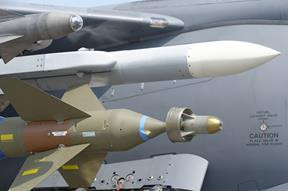Since the outbreak of the Russia-Ukraine conflict in February last year, the world has witnessed a series of conflicts, from frequent coups in Africa to the ongoing Israel-Palestine conflict. Despite new orders for arms dealers due to these conflicts, a recent report revealed a surprising downturn in global arms revenue last year, marking the first decline in seven years. However, looking ahead, there are "no signs" of a slowdown in demand.
On Monday, the Stockholm International Peace Research Institute (SIPRI) reported that in 2022, the world's top 100 arms dealers generated a total revenue of $597 billion from weapons and military services sales. Despite a significant rise in global demand, the revenue, calculated at real value, fell by 3.5% compared to 2021, marking the first decline since 2015.
This decrease is seen as "unexpected but temporary." The overall drop last year was mainly due to a decline in revenue from U.S. arms dealers. The primary reasons were labor shortages, rising costs, and supply chain blockages that prevented many European and American arms dealers from rapidly increasing their production capacity. Additionally, many of these arms dealers received new orders later in the year, meaning that despite the surge in demand, the revenue has not yet reflected in their accounts. However, considering the backlog of unfulfilled orders and the surge in new contracts, revenues are expected to grow significantly in 2023 or later.
U.S. Arms Dealers See Largest Revenue Drop
The U.S. faced the most apparent capacity constraints due to labor and supply chain issues. In 2022, 42 U.S. companies made it to the top 100 list, with a total revenue of $302 billion, accounting for 51% of the overall list's revenue. However, this was a 7.9% decrease compared to the previous year. Among these 42 U.S. companies, 32 saw a decline in revenue.
SIPRI senior researcher Diego Lopes da Silva noted that the U.S. typically produces more complex weapons and systems, requiring more components and thus being more susceptible to supply chain issues. For the current Russia-Ukraine conflict, the most needed military equipment is not necessarily expensive complex weapons but rather consumables like armored vehicles, ammunition, and artillery.
In addition to production speed being limited by capacity constraints, another reason is that as weapon providers for the Russia-Ukraine conflict, the U.S. and Europe are mainly consuming their stockpiles, which has not yet brought significant arms revenue.
European Arms Dealers See Slight Increase in Revenue
With the Russia-Ukraine conflict-related demand starting to impact, European arms dealers saw a slight increase in revenue. Last year, 26 European companies in the top 100 saw their revenue grow by 0.9%, reaching $121 billion.
The increase in European arms revenue was mainly driven by the demand for consumables like ammunition and armored vehicles due to the Russia-Ukraine conflict. German, Norwegian, and Polish companies all benefited from this demand. Poland, with only one company on the list, saw its defense company PGZ's weapons revenue increase by 13.5%. European companies Airbus and the Franco-German joint venture KNDS were also major contributors to the increase in European weapons revenue, primarily due to the delivery of long-term orders.
In contrast, regions like the Middle East, Asia, and Oceania, which mainly produce less complex weapons and systems, were able to meet the growing demand, resulting in better revenue performance.
Middle Eastern Arms Dealers Earn the Most
The Middle East region performed the best. It saw the largest increase among all regions last year, with the revenue of the seven listed Middle Eastern companies climbing to $17.9 billion, an 11% increase.
Turkey was the biggest winner in the region, with four companies on the list and a total revenue of $5.5 billion, a 22% increase compared to the previous year. The most notable performer was Turkey's Baykar company, driven by the widespread use of its drones in Ukraine, which saw its sales increase by 94%, making it the fastest-growing company on the list. This also allowed Baykar to make its debut on the top 100 list (ranked 76th).
Israel also saw a rapid increase in revenue. The three Israeli companies on the list had a total revenue of $12.4 billion, a 6.5% increase compared to the previous year.
SIPRI senior researcher Diego Lopes da Silva pointed out that Middle Eastern companies benefited from specializing in producing less complex weapons, allowing them to expand production more quickly to meet growing demand, with Turkey being a prime example.
Asian Companies Also Perform Well
According to the report, the revenue of the 22 listed companies from Asia and Oceania grew by 3.1%, reaching $134 billion, marking the second consecutive year that the region's arms dealers' revenue exceeded that of Europe.
The list included four South Korean companies, with a combined revenue decrease of 0.9%, mainly due to an 8.5% drop in revenue for the country's largest arms dealer, Hanwha. Two South Korean companies saw revenue growth, with LIG Nex1 being the most famous. However, considering the significant arms agreements signed by the South Korean government with Poland and the UAE, South Korean companies' revenue is expected to surge in the coming years.
Due to a lack of data, only two Russian companies made it to the top 100 list: Rostec (ranked 10th) and United Shipbuilding Corporation (ranked 36th). Their total arms revenue decreased by 12% to $20.8 billion. The report stated that part of the reason was the Western sanctions imposed on Russia, and delayed payments by the Russian government might also be a reason for the revenue decline last year.
As for Ukraine, the other party in the conflict, UkrOboronProm was the only Ukrainian company on the list, with its arms revenue actually decreasing by 10% to $1.3 billion. Despite a nominal increase in Ukrainian arms revenue, it was offset by the country's high inflation.






